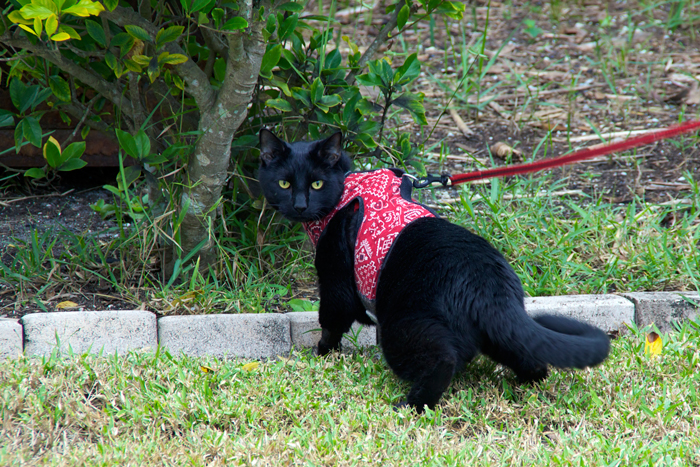The items you’ll need when taking your cat out for a stroll.
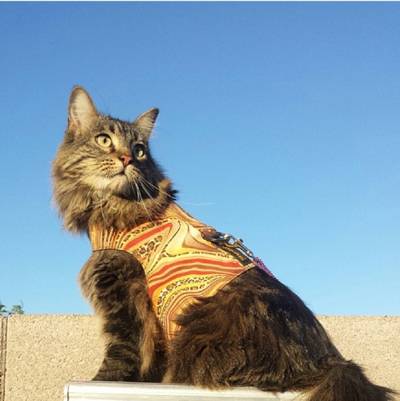
When someone first brings a cat home, the first thought is not usually, “I can’t wait to take my cat for a walk.” However, maybe it should be.
Cats benefit from new experiences and one of the most fun ways to socialize your cat is to take her out on a walk. The key to success is retaining control of your wily feline. Fortunately, many manufacturers are coming up with creative ways to help you safely take your cat out for walks.
Choose the Correct Equipment
Walking Vests: These vests are specially designed to help a cat feel secure and keep her from slipping out of it. The best-fitting models I’ve found are the Walking Vest from Sturdi Products, which uses snaps to attach the vest or the Kitty Holster from Crazy K Farm, which uses fabric fasteners.
If your cat is sensitive to the sound fabric fasteners make, you’ll want to use the vest from Sturdi. If your cat doesn’t mind the noise, the Crazy K Farm vest is a good option. Whichever you choose, you’ll need to make sure your cat’s vest fits snugly but not tightly. Your cat should be very comfortable in it.
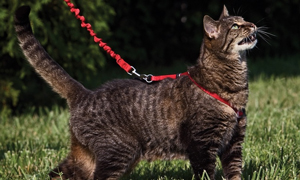
Harnesses: When shopping for a cat harness, your first priority is making sure your cat can’t slip out it. The Come With Me Kitty Harness from PetSafe is one of my favorite harnesses because it features a bungee-style leash and tightens automatically if your cat attempts to make a run for it. These harnesses are designed with your cat’s comfort in mind and make a great option for cats who are sensitive to jackets or clothing.
Collars: While it’s possible to walk your cat using only a collar, I don’t recommend it. First off, most collars are breakaway collars and will release at even slight pressure. Second, you risk damage to the throat and neck area if something scares your cat or if you jerk on the leash. Stay with walking vests and harnesses—you and your kitty will be much happier.
Start Slow
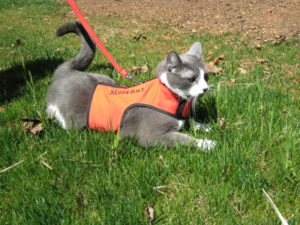
The first step to introducing your cat to a harness or leash is to start slow and choose your equipment wisely. Begin indoors by letting your at grow accustomed to wearing a harness and leash.
We’ve all seen the funny videos of cats refusing to walk on leash, but it doesn’t have to be that way. (If you haven’t seen any, here’s a fun one.)
If your cat chooses to lie down rather than be led around, you will need to let her adjust to it. Start by letting her get used to one piece of equipment at a time. Have your cat wear the harness or vest around the house for a few days (but be sure it’s only during times when you’re home). Be patient. It might take a few weeks before your cat begins to feel comfortable in her harness.
Preparing Your Cat Indoors

Once your cat is feeling comfortable in her harness, it’s time to try the leash. Again, you’ll want to try this indoors first. Fasten the leash to the harness and gently tug. Never drag your cat across a floor. Not only do you risk serious injury, you could increase her fear. Instead, use treats and wands to entice your cat to walk.
I prefer the treat and toy approach, Teaser wands make the perfect distraction for cats on leash because they enable you to control the toy while also holding the leash. Holding the teaser toy in one hand and the leash in the other, you can encourage your cat to move forward with only a twitch of a toy. I like the wands from NekoFlies; there are very few cats who can resist the lifelike movements of these toys.
Treats also work wonders if your cat is food motivated. Pieces of chicken (such as Halo’s Liv A Little) or tuna (such as the new Churu treats or Grilled Filets from Inaba Ciao should entice even the most hesitant cat. Reward your cat after even the most hesitant step and then continue to do so until she is moving across the room. Before long, your cat will be ready for the outdoors.
Taking Your Cat Outdoors Safely
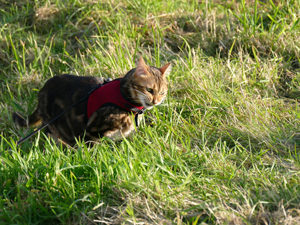
Before you take your cat outdoors, be sure she is wearing a collar with ID and is microchipped. If you have one, a GPS tracker is not a bad idea (I like the cat-sized one from PodTrackers). You should also make sure your cat is up-to-date on all vaccinations and is on a good heartworm medication before taking her outside.
Begin your outdoor exploration in a safe environment for the first few weeks. I prefer a fenced backyard where a cat is free from threats in the form of stray dogs, wildlife, loud noises, vehicles and people.
Cats have different personalities. Some cats like to be up high and others prefer the ground. Some cats prefer to flee any threat while others will fight it head on. Both can be walked outdoors in the proper environment if you’re prepared for reactions. For example, for cats who like to be up high, you’ll want a slightly longer leash (but not so long that you can’t easily retrieve your cat if she decides to go for a climb in a tree).
Safety is a priority. You should never walk your cat in an unsafe environment. Start slow and allow your cat to acclimate to the new sounds and smells. The result is that you will have a happier, well-adjusted cat who has the confidence to face any obstacle.
About the Author: Stacy Mantle is a full-time freelance writer, bestselling author and founder of PetsWeekly.com. She resides in the deserts of the Southwest with a few dogs, several cats and a very understanding husband.




